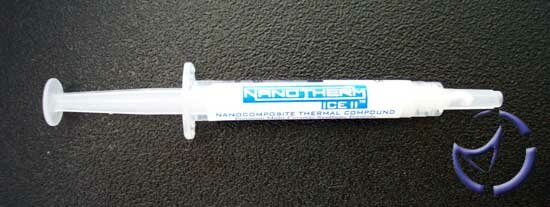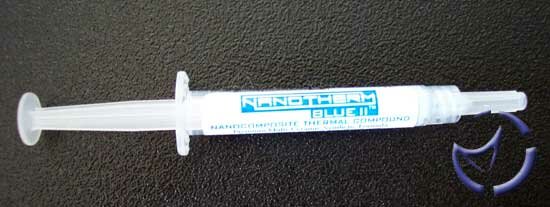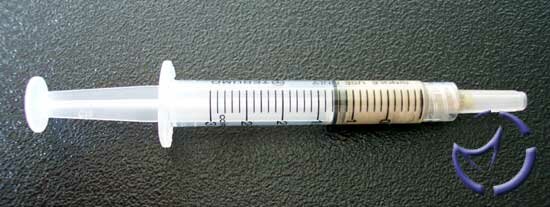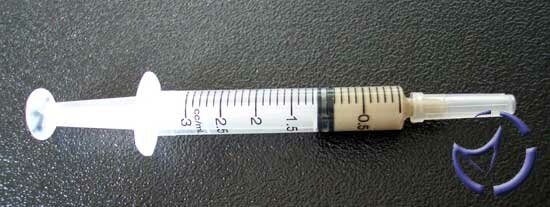|
Nanotherm Ice II and Blue II

Nanotherm is no stranger to us, and their Ice and Blue products were pretty good performance-wise. They've released a newer version now that improves on their past performance, and as before you can choose between Ice and Blue. Like their previous version, both are ceramic based, and non-electrically conductive.

For those of you who are unfamiliar with Nanotherm, the Ice and Blue are both chemically similar, except for the coloured tint in the "Blue" version. Through testing, I've always found that the blue is easier to apply, meaning, it was easier to tell when the right amount was applied. I'm not trying to say the "Ice" would be tougher, because it isn't. The viscosity is the same, but the visual aid in the Blue makes it more obvious. Here's part of an email when asked what other differences, if any, exists between the two...
There is a slight difference between the formulation of the Ice II and Blue II - besides the blue ceramic pigment that we use in the Blue II. The synthetic suspension fluid used in our Blue II formulation is different than the one used in the Ice II. Blue II's suspension fluid gives the compound a slightly higher temperature resistance characteristic and wider temperature range than the Ice II. Hence, the slight difference in price of the 2 products. In terms of the thermally conductive and "nano" particles used in each compound, both contain the same amount so the thermal performance of the Ice II and Blue II is about the same.
The improvements for both compounds is a new multisynthetic ceramic formulation. Neither contain silicon, which tends to degrade over time. I found both compounds slightly thicker than before, but neither were difficult to spread evenly.
Here are the rest of the specifications from ...
Nanotherm Ice II and Blue II are unique nanocomposite multiceramic thermal interface compounds that contain a special blend of engineered materials, including Boron Nitride, Aluminum Oxide, Aluminum Nitride and other nanopowders, compounded into a proprietary multisynthetic carrier fluid comprised of USDA authorized "food grade" lubricants.
Nanotherm Ice II and Blue II come in 2.0 gram tubes. Each syringe contains a volume of 1.5 cc/ml of thermal compound, providing a coverage area of about 30.5 sq. in. at an average layer thickness of .003". In terms of applications, each tube of Nanotherm contains enough thermal compound to cover:
32 to 44 small CPU cores
12 to 19 large CPU cores
5 to 10 heat plates
The following are some of the features, characteristics and benefits of Nanotherm II Thermal Compounds:
Cost-Effective, High Performance Thermal Interface Material
High Thermal Conductivity
Low Thermal Resistance
Excellent High and Low Temperature Characteristics
Electrically Insulative
Non-Hazardous
Spreads Smoothly & Evenly in Thin Layers
Viscous, Sticky Consistency
Fills Micropores & Grooves on Contact Surfaces
Fast, Easy Cleanup - No Mess
Excellent Barrier Properties to Oxygen and Moisture
Resistant to Separation, Leeching and Drying Out
High Pressure Resistance
Transparent to Microwave Radiation
Unless I'm totally blind, I couldn't spot any differences between the new specifications and the old, other than mentioning the new multiceramic compound. Previously, the Nanotherm products required a break-in period of about 48 to 72 hours until performance levels off. We noted the temperatures during testing the first day, and revisited the temperature readings a week later to see if this still applies.
Nanotherm Silver XTC

The Nanotherm Silver XTC is the newest entry into the Nanotherm product line. It differs from the Ice II and Blue II, both physically and chemically. It's due to be released this month (perhaps by the time you're reading this) so you can expect a proper product label on the syringe. This was actually the second sample we've received, and I was told that there were major improvements since the first sample was sent to us. There isn't any web information at this time, but I was emailed the official product description...
- Contains a highly optimized combination of sub-micron to low micron sized Silver particles
- Silver particles are 99.98% pure and are custom milled to our specifications
- Compound has a high density of silver particles; 80 to 83% silver by weight
- Also contains a special blend of Boron Nitride and "Nano" powders used in our Nanotherm II compounds
- Suspension fluid is a high temperature synthetic designed for operating temperatures in excess of 500'F
- Compound is non-electrically conductive, based on our preliminary testing
- Retail product will be packaged in clear, graduated 3 ml syringes
- Net weight of thermal compound will be 4.0 grams per syringe
Although there are no specific explanations, my guess is that ESG Associates developed this product to better establish themselves in the enthusiast market. I'm certain most of you are probably using some sort of "silver" compound, and no doubt Arctic Silver is the most popular.
Comparing Arctic Silver 3 to Nanotherm Silver XTC, it appears that The Silver XTC has a higher silver content. Whether or not it's better, we'll have to see. One thing I noticed is it is a breeze to clean off when compared to Arctic Silver. Usually, when I need to get AS3 off my CPU, I have to resort to both rubbing alcohol, and dish soap (don't ask, but it works). With the Silver XTC, rubbing alcohol works just fine. Another thing I noticed is it doesn't really look that silver to me, but more like a yellow-brown. Oh well, it's going to be under a heatsink anyways so I couldn't care less if it was navy blue.
Nanotherm EXP

We received a prototype that is still undergoing development, though I am under the impression it will be out sooner than we think. I don't have any hard info about the EXP (short for experimental) other than it won't be classified as Nanotherm Silver II. We'll be testing it in this roundup, but you'll have to understand that performance may or may not be the same as the final shipping product.
Application was is very smooth, and it was extremely easy to apply. Cleanup was a breeze as well.
Previous Page - Introduction and History
Next Page - Competition
|
